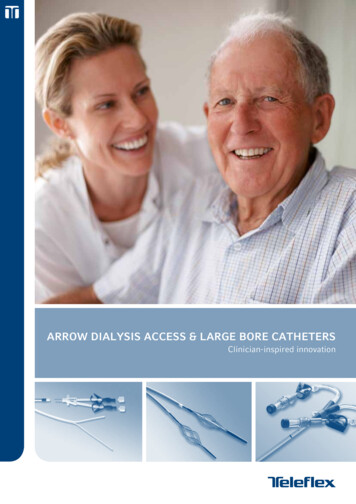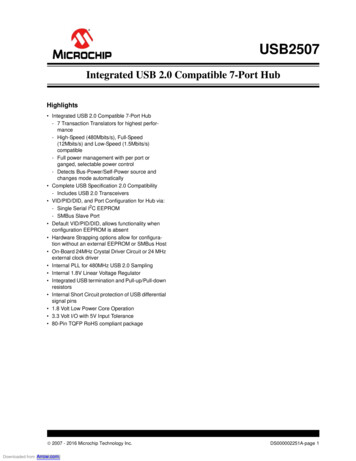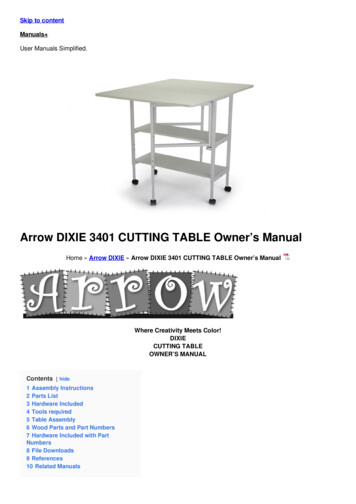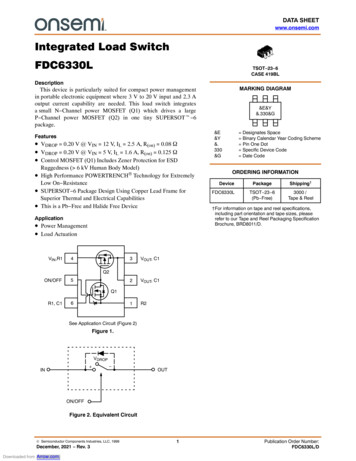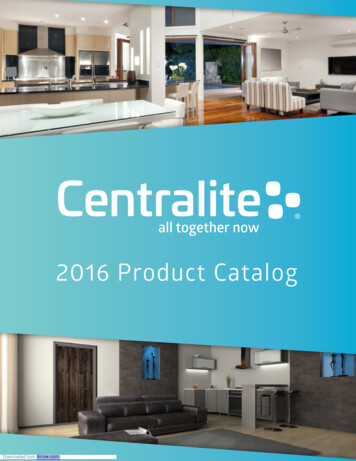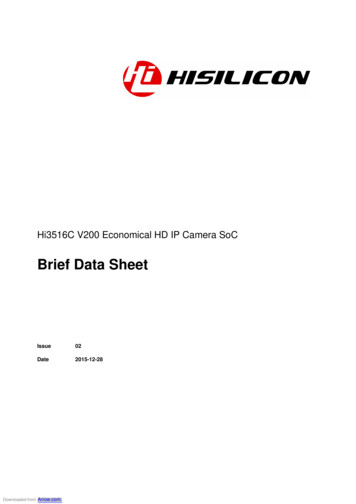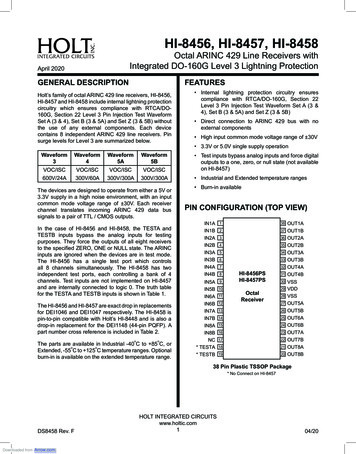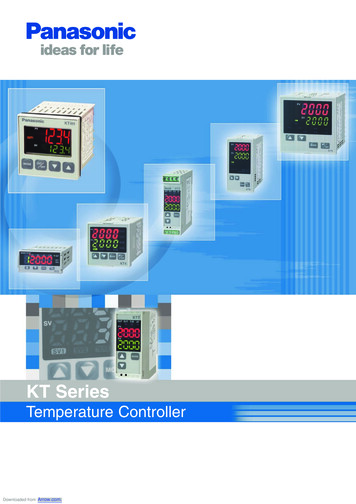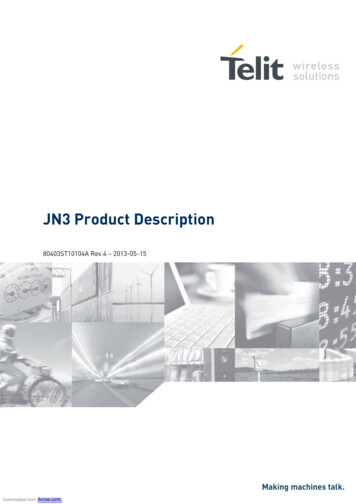
Transcription
JN3 Product Description80403ST10104A Rev.4 – 2013-05-15Downloaded from Arrow.com.
JN3 Product Description80403ST10104A Rev.4 – 2013-05-15APPLICABILITY TABLEPRODUCTJN3Reproduction forbidden without written authorization from Telit Communications S.p.A. - All Rights Reserved.Mod. 0808 2011-07 Rev.2Downloaded from Arrow.com.Page 2 of 38
JN3 Product Description80403ST10104A Rev.4 – 2013-05-15SPECIFICATIONS SUBJECT TO CHANGE WITHOUT NOTICENoticeWhile reasonable efforts have been made to assure the accuracy of this document, Telitassumes no liability resulting from any inaccuracies or omissions in this document, or fromuse of the information obtained herein. The information in this document has been carefullychecked and is believed to be entirely reliable. However, no responsibility is assumed forinaccuracies or omissions. Telit reserves the right to make changes to any products describedherein and reserves the right to revise this document and to make changes from time to timein content hereof with no obligation to notify any person of revisions or changes. Telit doesnot assume any liability arising out of the application or use of any product, software, orcircuit described herein; neither does it convey license under its patent rights or the rights ofothers.It is possible that this publication may contain references to, or information about Telitproducts (machines and programs), programming, or services that are not announced in yourcountry. Such references or information must not be construed to mean that Telit intends toannounce such Telit products, programming, or services in your country.CopyrightsThis instruction manual and the Telit products described in this instruction manual may be,include or describe copyrighted Telit material, such as computer programs stored insemiconductor memories or other media. Laws in the Italy and other countries preserve forTelit and its licensors certain exclusive rights for copyrighted material, including theexclusive right to copy, reproduce in any form, distribute and make derivative works of thecopyrighted material. Accordingly, any copyrighted material of Telit and its licensorscontained herein or in the Telit products described in this instruction manual may not becopied, reproduced, distributed, merged or modified in any manner without the expresswritten permission of Telit. Furthermore, the purchase of Telit products shall not be deemedto grant either directly or by implication, estoppel, or otherwise, any license under thecopyrights, patents or patent applications of Telit, as arises by operation of law in the sale of aproduct.Computer Software CopyrightsThe Telit and 3rd Party supplied Software (SW) products described in this instruction manualmay include copyrighted Telit and other 3rd Party supplied computer programs stored insemiconductor memories or other media. Laws in the Italy and other countries preserve forTelit and other 3rd Party supplied SW certain exclusive rights for copyrighted computerprograms, including the exclusive right to copy or reproduce in any form the copyrightedcomputer program. Accordingly, any copyrighted Telit or other 3rd Party supplied SWcomputer programs contained in the Telit products described in this instruction manual maynot be copied (reverse engineered) or reproduced in any manner without the express writtenpermission of Telit or the 3rd Party SW supplier. Furthermore, the purchase of Telit productsshall not be deemed to grant either directly or by implication, estoppel, or otherwise, anylicense under the copyrights, patents or patent applications of Telit or other 3rd Party suppliedSW, except for the normal non-exclusive, royalty free license to use that arises by operationof law in the sale of a product.Reproduction forbidden without written authorization from Telit Communications S.p.A. - All Rights Reserved.Mod. 0808 2011-07 Rev.2Downloaded from Arrow.com.Page 3 of 38
JN3 Product Description80403ST10104A Rev.4 – 2013-05-15Usage and Disclosure RestrictionsLicense AgreementsThe software described in this document is the property of Telit and its licensors. It isfurnished by express license agreement only and may be used only in accordance with theterms of such an agreement.Copyrighted MaterialsSoftware and documentation are copyrighted materials. Making unauthorized copies isprohibited by law. No part of the software or documentation may be reproduced, transmitted,transcribed, stored in a retrieval system, or translated into any language or computer language,in any form or by any means, without prior written permission of TelitHigh Risk MaterialsComponents, units, or third-party products used in the product described herein are NOTfault-tolerant and are NOT designed, manufactured, or intended for use as on-line controlequipment in the following hazardous environments requiring fail-safe controls: the operationof Nuclear Facilities, Aircraft Navigation or Aircraft Communication Systems, Air TrafficControl, Life Support, or Weapons Systems (High Risk Activities"). Telit and its supplier(s)specifically disclaim any expressed or implied warranty of fitness for such High RiskActivities.TrademarksTELIT and the Stylized T Logo are registered in Trademark Office. All other product orservice names are the property of their respective owners.Copyright Telit Communications S.p.A. 2013.Reproduction forbidden without written authorization from Telit Communications S.p.A. - All Rights Reserved.Mod. 0808 2011-07 Rev.2Downloaded from Arrow.com.Page 4 of 38
JN3 Product Description80403ST10104A Rev.4 – 2013-05-15Contents1.Introduction . 81.1.Scope . 81.2.Audience. 81.3.Contact Information, Support . 81.4.Document Organization . 91.5.Text Conventions . 91.6.Related Documents . 102.General Product Description . 113.Technical Description. 123.1.Product Compatibility . 123.2.Receiver Architecture . 133.3.Major Components . 3.3.9.3.3.10.4.GSD4e Chip . 13RF IN . 14VCC IN . 14VBATT . 14Host Port . 14MEMS Sensor Interface . 14SAW Filter (1.575 GHz) . 14TCXO . 14RTC . 14Memory . 143.4.Physical Characteristics. 153.5.Mechanical Specification . 153.6.External Antenna Connection . 153.7.Input/Output and Power Connections . 153.8.Environmental . 153.9.Compliances . 153.10.Marking/Serialization . 163.11.Active Antenna Gain Requirements . 16Software . 174.1.TTFF (Time to First Fix) . 17Reproduction forbidden without written authorization from Telit Communications S.p.A. - All Rights Reserved.Mod. 0808 2011-07 Rev.2Downloaded from Arrow.com.Page 5 of 38
JN3 Product Description80403ST10104A Rev.4 – 2013-05-154.1.1.4.1.2.4.1.3.Hot Start . 17Warm Start . 17Cold Start . 174.2.AGPS . 184.3.Time Mark Pulse (1PPS) . 184.4.Power Management . 184.4.1.4.5.Adaptive Trickle Power (ATP) . 18Differential Aiding . 184.5.1.Satellite Based Augmentation Systems (SBAS) . 184.6.5Hz Update Rate . 194.7.Dynamic Constraints . 195.Performance Data . 206.Electrical Requirements . 216.1.Power Supply . 216.1.1.6.1.2.6.2.External Antenna Voltage . 216.3.RF (Radio Frequency) Input . 216.4.Antenna Gain. 216.5.Burnout Protection . 216.6.Jamming Performance . 216.7.Flash Upgradability (Flash only). 226.8.Patch Updates (EEPROM only) . 226.9.Data Input/Output Specifications . 226.9.1.6.9.2.6.9.3.7.8.VCC IN . 21VBATT . 21Voltages and Currents . 22DC Electrical Characteristics . 23Pinout Description. 24Software Interface . 257.1.NMEA Output Messages . 257.2.SiRF OSP Output Messages . 257.3.Software Functions and Capabilities . 26Mechanical Drawing . 27Reproduction forbidden without written authorization from Telit Communications S.p.A. - All Rights Reserved.Mod. 0808 2011-07 Rev.2Downloaded from Arrow.com.Page 6 of 38
JN3 Product Description80403ST10104A Rev.4 – 2013-05-159.Conformity Assessment. 299.1.Declaration of Conformity . 299.2.R&TTE Notified Body Opinion . 3010.Evaluation Kit . 3111.Product Handling . 3211.1.Product Packaging and Delivery . 3211.2.Moisture Sensitivity. 3311.3.ESD Sensitivity. 3311.4.Safety . 3311.5.Disposal . 3312.Ordering Information. 3413.Glossary and Acronyms . 3514.Safety Recommendations . 3715.Document History . 38Reproduction forbidden without written authorization from Telit Communications S.p.A. - All Rights Reserved.Mod. 0808 2011-07 Rev.2Downloaded from Arrow.com.Page 7 of 38
JN3 Product Description80403ST10104A Rev.4 – 2013-05-151.Introduction1.1.ScopeScope of this document is to give an overview of new standalone GPS module JN3.1.2.AudienceThis document is intended for customers developing applications using JN3.1.3.Contact Information, SupportFor general contact, technical support, to report documentation errors and to ordermanuals, contact Telit Technical Support Center (TTSC) , port-center/contact.phpFor detailed information about where you can buy the Telit modules or forrecommendations on accessories and components visit:http://www.telit.comTo register for product news and announcements or for product questions contactTelit Technical Support Center (TTSC).Our aim is to make this guide as helpful as possible. Keep us informed of yourcomments and suggestions for improvements.Telit appreciates feedback from the users of our information.Reproduction forbidden without written authorization from Telit Communications S.p.A. - All Rights Reserved.Mod. 0808 2011-07 Rev.2Downloaded from Arrow.com.Page 8 of 38
JN3 Product Description80403ST10104A Rev.4 – 2013-05-151.4.Document OrganizationThis document contains the following chapters:“Chapter 1: “Introduction” provides a scope for this document, target audience,contact and support information, and text conventions.“Chapter 2: “General Description” gives an overview of the features of the product.“Chapter 3: “Technical Description” describes the features of the product.“Chapter 4: “Software” describes in details the characteristics of the product.“Chapter 5: “Performance Data” shows the performance information of the product.“Chapter 6: “Electrical Requirements”characteristics of the product.describes in details the electrical“Chapter 7: “Software Interface” provides some fundamental hints about theconformity assessment that the final application might need.“Chapter 8: “Mechanical Drawings” provides info about Hardware interfaces.“Chapter 9: “Conformity Assessment” provides Declaration of Conformity andNotified Body Opinions.“Chapter 10: “Evaluation Kit” provides some fundamental hints about evaluation Kit.“Chapter 11: “Product Handling” describes the packaging and mounting of themodule.“Chapter 12: “Ordering Information” contains the ordering SKUs for the product“Chapter 12: “Glossary and acronyms” contain the explanation of acronyms used inthe present document“Chapter 13: “Safety Recommendation” provides some safety recommendations thatmust be follow by the customer in the design of the application that makes use of theJN3.“Chapter 14: “Document History” provides the history of the present document.1.5.Text ConventionsDanger – This information MUST be followed or catastrophic equipment failureor bodily injury may occur.Caution or Warning – Alerts the user to important points about integrating themodule, if these points are not followed, the module and end user equipmentmay fail or malfunction.Reproduction forbidden without written authorization from Telit Communications S.p.A. - All Rights Reserved.Mod. 0808 2011-07 Rev.2Downloaded from Arrow.com.Page 9 of 38
JN3 Product Description80403ST10104A Rev.4 – 2013-05-15Tip or Information – Provides advice and suggestions that may be useful whenintegrating the module.All dates are in ISO 8601 format, i.e. YYYY-MM-DD.1.6.Related Documents JN3 Hardware User Guide, JN3 EVK User Guide, JF2 JN3 Low Power Modes Application Note JF2 JN3 MEMS Application NoteReproduction forbidden without written authorization from Telit Communications S.p.A. - All Rights Reserved.Mod. 0808 2011-07 Rev.2Downloaded from Arrow.com.Page 10 of 38
JN3 Product Description80403ST10104A Rev.4 – 2013-05-152.General Product DescriptionBuilding upon the SiRFstarIV architecture’s high-performance, the JN3 device incorporatesinnovations such as SiRFInstantFix and Active Jammer Removal. The JN3 can navigate to-160dBm and track to -163dBm, providing higher coverage, accuracy and availability. Thisnext generation Jupiter Module consumes only 13mA (3.3V) in 1-Hz TricklePower mode.The JN3 offers A-GPS support and operate with a 3.3V power supply. JN3 supports a fullrange of satellite-based augmentation systems, including WAAS, EGNOS, MSAS andGAGAN.The GPS module combines the SiRFstarIV GSD4e GPS engine, TCXO, SAW filter,RTC, LDO, level conversion and memory (Flash and EEPROM devices only).Reproduction forbidden without written authorization from Telit Communications S.p.A. - All Rights Reserved.Mod. 0808 2011-07 Rev.2Downloaded from Arrow.com.Page 11 of 38
JN3 Product Description80403ST10104A Rev.4 – 2013-05-153.Technical DescriptionHigh-speed Location Engine – Twice the available DSP memory and search speed ofSiRFstarIII architecture for enhanced sensitivity and navigation performance, greatercoverage, reduced time to fix and improved positional accuracy.Battery Backup is supported via a separate pin for applications that use a battery backupsource.MEMS Sensor Interface (I2C DR Port) – Static detection is implemented and utilizes anaccelerometer to determine if the module is moving in order to pin position.Active Jammer Remover – Advanced DSP technology actively identifies and removesjammers prior to correlation. This feature maximizes GPS performance and helps identifyissues during the design phase. Up to 8 jammers can be identified and removed.5Hz Navigation – The JN3 can run with a navigation update rate of 1Hz or 5Hz. This iscontrollable in NMEA and OSP mode. Note that the UART baud rate will need to beincreased to support the higher message output (about 38400 baud minimum in NMEA).High Performance Solution:‐ High sensitivity navigation engine (PVT) tracks as low as -163dBm‐ 48 track verification channels‐ SBAS (WAAS), EGNOS, MSAS, GAGANActive Jammer Remover:‐ Removes in-band jammers up to 80 dB-Hz‐ Tracks up to 8 CW jammersAdvanced Navigation Features:‐ Smart sensor I2C interface‐ Interrupt input for context change detection3.1.Product CompatibilityThe JN3 incorporates a new technology far advanced compared to the previous SiRFstarIIIdesigns. It offers an upgrade path from existing Telit and competitive designs.NMEA version 3.0 protocol is supported as well as the new SiRF ONE SOCKET binaryPROTOCOL (OSP).Reproduction forbidden without written authorization from Telit Communications S.p.A. - All Rights Reserved.Mod. 0808 2011-07 Rev.2Downloaded from Arrow.com.Page 12 of 38
JN3 Product Description80403ST10104A Rev.4 – 2013-05-153.2.Receiver ArchitectureThe functional architecture of the JN3 receiver is shown in Figure 1.Note: The LNA is included in the GPS chip for passive antenna operation.ACTIVE/PASSIVEVBATTVCC pacitorsI2C1PPSFlash orEEPROMUARTFigure 1 – JN3 ArchitectureNote: LNA is included in the GPS chip for passive antenna operation.3.3.Major ComponentsAll power supply components are on board including capacitors.3.3.1.GSD4e ChipThis single chip GPS device includes an integrated Baseband and RF sections. The LNAamplifies the GPS signal and provides enough gain for the receiver to use a passive antenna.A very low noise design is utilized to provide maximum sensitivity. This LNA is internal tothe GPS baseband and can be switched between low and high gain mode.Reproduction forbidden without written authorization from Telit Communications S.p.A. - All Rights Reserved.Mod. 0808 2011-07 Rev.2Downloaded from Arrow.com.Page 13 of 38
JN3 Product Description80403ST10104A Rev.4 – 2013-05-153.3.2.RF INGPS RF signal input. This requires an external BIAS-T and antenna voltage supply for activeantenna.3.3.3.VCC INThis is the primary 2.85V to 3.6V supply voltage for the module. A voltage of 2.85V to 3.3Vis recommended.3.3.4.VBATTThe Battery Backup supply voltage is 2.2V to 3.3V. A typical low current supply for ensuringthe RTC/BBRAM is kept running to ensure HOT/WARM starts. Higher battery backupsupply voltages are catered for up to 3.6V.3.3.5.Host PortThe JN3 has a single serial communications port -- UART. See the Designer’s Notes for moredetails.3.3.6.MEMS Sensor InterfaceThe DR I2C port is used for MEMS sensor interface. The JN3 ROM2.2 9600 baud ratevariant will not support external MEMS. Reference the Designer’s Notes for more details onhow to connect to an accelerometer and/or magnetic sensor to this port.3.3.7.SAW Filter (1.575 GHz)This filters the GPS signal and removes unwanted signals caused by external influences thatwould corrupt the operation of the receiver. The filtered signal is fed to the RF input ofGSD4e chipset for further processing.3.3.8.TCXOThis highly stable 16.369 MHz oscillator controls the down conversion process for the RFblock.3.3.9.RTCThe Real Time Clock allows Hot/Warm starts and low power modes.3.3.10.MemoryThe JN3 Flash design includes a 16MB Flash storage device for operational software andsatellite data.The JN3 EEPROM design includes a 512KB EEPROM storage device for patch code andsatellite data.The JN3 ROM-only design does not include on-module memory. External Host memory maybe used to store patch code and satellite data.Reproduction forbidden without written authorization from Telit Communications S.p.A. - All Rights Reserved.Mod. 0808 2011-07 Rev.2Downloaded from Arrow.com.Page 14 of 38
JN3 Product Description80403ST10104A Rev.4 – 2013-05-153.4.Physical CharacteristicsThe JN3 receiver has advanced miniature packaging with a base metal of copper and anElectroless Nickel Immersion Gold (ENIG) finish.It has 24 interface pads. These are castellated edge contacts.3.5.Mechanical SpecificationThe physical dimensions of the JN3 are as follows:‐length: 16.0 mm 0.1 mm‐width: 12.2 mm 0.1 mm‐thickness: 2.4 mm 0.2 mm‐weight: 1 g maxRefer to Figure 2 for the JN3 mechanical layout drawing.3.6.External Antenna ConnectionThe RF connection for the external antenna has a characteristic impedance of 50 ohms.3.7.Input/Output and Power ConnectionsThe I/O (Input / Output) and power connections use surface mount pads.3.8.EnvironmentalThe environmental operating conditions of the JN3 are as follows:3.9.‐temperature: –40oC to 85oC (measured on the shield)‐humidity: up to 95% non-condensing or a wet bulb temperature of 35oC‐shock (non-operating): 18 G peak, 5 msCompliancesThe JN3 complies with the following:‐Directive 2002/95/EC on the restriction of the use of certain hazardous substances inelectrical and electronic equipment (RoHS)‐Manufactured in an ISO 9000: 2000 accredited facility‐Manufactured to TS 16949 requirement (upon request)Reproduction forbidden without written authorization from Telit Communications S.p.A. - All Rights Reserved.Mod. 0808 2011-07 Rev.2Downloaded from Arrow.com.Page 15 of 38
JN3 Product Description80403ST10104A Rev.4 – 2013-05-153.10.Marking/SerializationThe JN3 supports a 2D barcode indicating the unit serial number below. The Telit13-character serial number convention is:3.11.‐characters 1 and 2: year of manufacture (e.g. 12 2012, 13 2013)‐characters 3 and 4: week of manufacture (01 to 52, starting first week in January)‐character 5: manufacturer code‐characters 6 and 7: product and type‐character 8: product revision‐characters 9-13: sequential serial numberActive Antenna Gain RequirementsLNA Gain(dB)GPS Noise Figure (dB)Recommended ExternalGain Range (dB)Low6.0 – 10.08.5 – 9.516-30High (default)16.0 – 20.04.08-18LNA Gain SettingTable 1 – Active Antenna Gain RequirementsNotes:1. Recommended external gain range is total any external gain, such as antenna orexternal LNA and any passive loss due to cables, connectors, filters, matchingnetwork, etc.2. In the High Gain setting an external LNA is not recommended.3. In the Low Gain setting, the noise figure of the external LNA or active antenna mustbe chosen to ensure that the total cascaded noise figure is sufficiently low to meetoverall system design requirements.Reproduction forbidden without written authorization from Telit Communications S.p.A. - All Rights Reserved.Mod. 0808 2011-07 Rev.2Downloaded from Arrow.com.Page 16 of 38
JN3 Product Description80403ST10104A Rev.4 – 2013-05-154.Software4.1.TTFF (Time to First Fix)TTFF is the actual time required by a GPS receiver to achieve a valid position solution. Thisspecification will vary with the operating state of the receiver, the length of time since the lastposition fix, the location of the last fix, and the specific receiver design.4.1.1.Hot StartA hot start results from a software reset after a period of continuous navigation, or a returnfrom a short idle period (i.e. a few minutes) that was preceded by a period of continuousnavigation. In this state, all of the critical data (position, velocity, time, and satelliteephemeris) is valid to the specified accuracy and available in memory.4.1.2.Warm StartA warm start typically results
A warm start typically results from user-supp lied position and time initialization data or continuous RTC operation with an accurate last known position available in memory. In this state, position and time data are present and valid but ephemeris data validity has expired. 4.1.3. Cold Start
